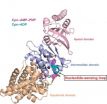Doctors find new way to predict recurrent stroke
2012-02-27
(Press-News.org) New research from the University of Calgary's Hotchkiss Brain Institute (HBI) shows that using a CT (computerised tomography) scan, doctors can predict if patients who have had a transient ischemic attack (TIA) or minor stroke, with neurological symptoms such as weakness or speech issues, are at risk for another more severe stroke. This vital information can help doctors decide if stronger medications should be used to prevent future episodes, or if a patient can be safely sent home.
Currently, doctors can use a brain MRI (magnetic resonance imaging) scan to predict if a TIA patient is at high risk for a second stroke. Unfortunately however, MRI machines are not immediately available for most of Canada's population. In most centres, including rural hospitals, CT scans are readily available. This study sought to determine whether a CT scan would be as effective at predicting stroke risk as MRI.
"Many physicians may not have access to an MRI machine to see what is happening in the brain," says Dr. Shelagh Coutts, a member of the HBI, associate professor in the Department of Clinical Neurosciences and lead author of the study. "Therefore, this study could allow medical interventions to be more widely available than in just the specialised centres that have access to MRI."
In order to assess stroke risk, Coutts and colleagues used an injection of dye to visualize the blood vessels from the heart all the way to the brain. This test is called a CT angiogram, which can easily be administered as part of a routine CT scan. The researchers found that patients who had evidence of blockages or narrowed vessels on their CT scans were at high risk for a recurrent stroke. Further, they found that the CT angiogram scan was able to predict the recurrence of stroke with the same accuracy as an MRI.
Shirley Christensen, 79, suffered an episode of transient speech disturbance and was diagnosed with a TIA, two weeks ago. She was able to identify the onset of her symptoms and sought medical help. Doctors at the Foothills Medical Centre's Calgary Stroke Program were able to use a CT scan to determine that her risk of another stroke was very low and she was released from hospital. "I am glad I was able to be released and come back at a later date for an MRI scan," she says. Previously physicians would have admitted her to hospital for further investigations. This work allows low-risk patients to be managed safely at home rather than being admitted to hospital, which has the added benefit of reducing strain on the healthcare system.
"Even in centres that have MRI machines, there are often delays in getting patients into a scan. This research has an immediate impact and lets us use readily accesible tools to help patients," says Coutts.
The research is published in the February on-line edition of the journal Stroke.
INFORMATION:
The study was supported by the Canadian Institutes of Health Research and a Pfizer Cardiovascular Research Award. Dr. Coutts is an Alberta Innovates-Health Solutions clinical investigator and recipient of the Heart and Stroke Foundation of Canada's Distinguished Clinician Scientist award.
END
ELSE PRESS RELEASES FROM THIS DATE:
2012-02-27
In the crash-car derby between heavy and light isotopes vying for the coolest spots as magma turns to solid rock, weightier isotopes have an edge, research led by Case Western Reserve University shows.
This tiny detail may offer clues to how igneous rocks form.
As molten rock cools along a gradient, atoms want to move towards the cool end. This happens because hotter atoms move faster than cooler atoms and, therefore, hotter atoms move to the cool region faster than the cooler atoms move to the hot region.
Although all isotopes of the same element want to move towards ...
2012-02-27
From spaghetti-like sea anemones to blobby jellyfish to filigreed oak trees, each species in nature is characterized by a unique size and shape. But the evolutionary changes that produce the seemingly limitless diversity of shapes and sizes of organisms on Earth largely remains a mystery. Nevertheless, a better understanding of how cells grow and enable organisms to assume their characteristic sizes and shapes could shed light on diseases that involve cell growth, including cancer and diabetes.
Providing new information about the evolution of the diversity of sizes and ...
2012-02-27
For decades, scientists have understood that there is a genetic component to intelligence, but a new Harvard study has found both that most of the genes thought to be linked to intelligence are probably not in fact related to it, and identifying intelligence's specific genetic roots may still be a long way off.
Led by David I. Laibson '88, the Robert I. Goldman Professor of Economics, and Christopher F. Chabris '88, PhD '99, Assistant Professor of Psychology at Union College, a team of researchers examined a dozen genes using large data sets that included both intelligence ...
2012-02-27
PHILADELPHIA -- Would you be able to find an automated external defibrillator if someone's life depended on it? Despite an estimated one million AEDs scattered around the United States, the answer, all too often when people suffer sudden cardiac arrests, is no.
In a Perspective piece published online this week in the journal Circulation: Cardiovascular Quality Outcomes, two researchers from the Perelman School of Medicine at the University of Pennsylvania outline the tremendous potential associated with greater utilization of AEDs in public places and a method to find ...
2012-02-27
LOS ALAMOS, New Mexico, February 24, 2012—A multinational team of scientists has developed a process for creating glass-based, inorganic light-emitting diodes (LEDs) that produce light in the ultraviolet range. The work, reported this week in the online Nature Communications, is a step toward biomedical devices with active components made from nanostructured systems.
LEDs based on solution-processed inorganic nanocrystals have promise for use in environmental and biomedical diagnostics, because they are cheap to produce, robust, and chemically stable. But ...
2012-02-27
CLEMSON — A study of X-rays emitted a long time ago in a galaxy far, far away has unmasked a stellar mass black hole in Andromeda, a spiral galaxy about 2.6 million light-years from Earth.
Two Clemson University researchers joined an an international team of astronomers, including scientists at Germany's Max Planck Institute for Extraterrestrial Physics, in publishing their findings in a pair of scientific journals this week.
Scientists had suspected the black hole was possible since late 2009 when an X-ray satellite observatory operated by the Max Planck Institute ...
2012-02-27
NEW YORK – February 24, 2012 – A forthcoming article in the Journal of Consumer Research by Professor Michel Tuan Pham, Kravis Professor of Business, Marketing, Columbia Business School; Leonard Lee, Associate Professor, Marketing, Columbia Business School; and Andrew Stephen, PhD '09, currently Assistant Professor of Business Administration, Joseph M. Katz Graduate School of Business, University of Pittsburgh, finds that a higher trust in feelings may result in more accurate predictions about a variety of future events. The research will also be featured in Columbia Business ...
2012-02-27
The gold standard for nanotechnology is nature's own proteins. These biomolecular nanomachines – macromolecules forged from peptide chains of amino acids - are able to fold themselves into a dazzling multitude of shapes and forms that enable them to carry out an equally dazzling multitude of functions fundamental to life. As important as protein folding is to virtually all biological systems, the mechanisms behind this process have remained a mystery. The fog, however, is being lifted.
A team of researchers with the U.S. Department of Energy (DOE)'s Lawrence Berkeley ...
2012-02-27
Patients with heart disease who took cholesterol-lowering statins were significantly less likely to develop depression than those who did not, in a study by Mary Whooley, MD, a physician at the San Francisco VA Medical Center and a professor of medicine at the University of California, San Francisco.
The study was published electronically in the Journal of Clinical Psychiatry (February 21, 2012).
Whooley and her research team evaluated 965 heart disease patients for depression, and found that the patients who were on statins were significantly less likely to be clinically ...
2012-02-27
NEW YORK – February 24, 2012 – A recent study in the Review of Financial Studies proposes a new, valuation-based measure of equity market segmentation. Equity market segmentation occurs when stocks of similar risk in different countries are priced differently. The study, by Columbia Business School Professor Geert Bekaert, Chazen Senior Scholar at The Jerome A. Chazen Institute of International Business at Columbia Business School and the Leon G. Cooperman Professor of Finance and Economics, uncovers the factors that cause variation in market segmentation, both through ...
LAST 30 PRESS RELEASES:
[Press-News.org] Doctors find new way to predict recurrent stroke




